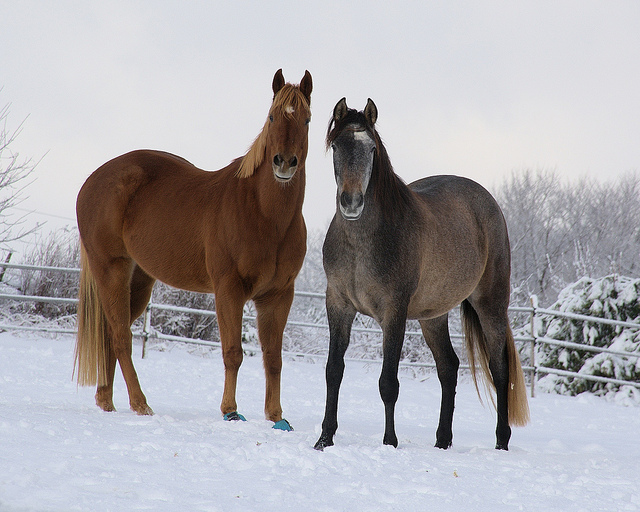
Now that we’re getting into the depths of winter and the temperatures are getting more extreme, you need to make sure that you know proper cold-weathered horse care, especially if this is your first season owning your own equine or barn. We’ve outlined some general winter horse care tips and things you should avoid doing in order to ensure your beloved companion stays healthy and happy all season long. Depending on your horses’ preferences, where you live and how frigid your winters are, you may need to do more or less of the suggestions touched on below.
- Increase Food Rations—As temperatures dip, your horses are going to be burning more calories than ever in order to keep themselves warm. This means that, if you don’t increase your feed rations or switch to a higher calorie feed, you run the risk of your horse losing too much weight and getting too cold. You should converse with your veterinarian about how much you should be increasing feed or the type of feed you should switch to, as they will be able to tell you the best suggestions for your horse’s specific needs.
- Ensure the Water Doesn’t Freeze Over—During the winter your horse will be consuming more food in order to keep their energy reserves up. This food, especially hay and grain, contains minimal moisture. Therefore, take extra measures to ensure that your equines have access to water to prevent dehydration and the health problems it causes. Where there are freezing temperatures, there is ice, so you need to make sure your horses’ water buckets don’t freeze over. To save yourself the trouble of going out to the paddock multiple times a day to chip away the ice, consider investing in a heating device or other type of de-icer.
- Continue Exercising—Just because you feel like being lazy (increased rations of eggnog will do that to you), doesn’t mean your horse is allowed to get out of shape. If the elements prevent you from riding, you should turn horses out daily with a longe line. If you do decide to brave the elements and ride during the season, remember to take an easy if your equine isn’t routinely receiving vigorous workouts. Overriding an out-of-shape horse can cause injury and strain so, if your horse’s exercise regime has lessened during the winter, start off with short, slow journeys and then gradually increase the intensity.
- Give Horses Air—As tempting as it may be to keep horses inside all winter long, they are actually healthier and happier staying outdoors as long as they have proper shelter from the elements. Adequate protection means that the structure must have at least three sides and a roof, though some people believe that, depending on the weather, a large cluster of trees or an open-sided shed works well too. If horses are allowed to let their winter coat grow in and have access to appropriate shelter, most can tolerate temperatures as low as -40 degrees. If you do need to bring your horses inside, try to do so only at night.
- Don’t Over Blanket—Over blanketing is probably one of the most common mistakes horse owners make. When you want nothing more than to wrap yourself up in a blanket, don’t assume that your equine companion desires the same. While horses with full or partial body clips do need blankets during the winter, an unclipped horse with a winter coat doesn’t require one. If you do clip your horse, make sure you’re not putting too heavy of a blanket on him. Usually a medium weight turnout or stable blanket from brands like WeatherBeeta or Amigo will suffice for typical cold weather. Over blanketing can lead to overheating and dehydration.
- Keep Up with Farrier & Grooming—Just because horses’s feet are buried in snow or you haven’t ridden them in a while, doesn’t mean that they should go without regular visits from the farrier and daily grooming. A horse should have their feet taken care of every six to eight weeks no matter what season it is! Regular grooming allows you to take inventory of your horses’ health and make sure they aren’t getting sick or have been injured.
- Paddock Maintenance—While it may be hard to see the state of your horses paddock when it’s covered in snow, you still need to make sure it’s not a hazardous. Ice buildup can cause slips and falls, which can lead to serious injuries for your horse. Some owners try to add sand to paddocks in order to give their horses more traction, or salt to melt away ice. Don’t mix the too because the horses may ingest the sand when they try to (inevitably) lick up the salt. If there is heavy snowfall, it’s a good idea to remove some of the snow so that your horse can easily access food, water, and shelter.

